#UNESCO's Tentative World Heritage List
Explore tagged Tumblr posts
Text
Kazbegi, Gudauri, Zhinvali Tour Georgia

View On WordPress
#12th Century Church of the Cross#13th Century Feudal Dynasty Eristavis of Aragvi#Abkhazia Region#Ananuri Fortress and Church#Ananuri Tentative List UNESCO World Heritage Program#Aragvi River#Aragvi Valley#Bagrationi Dynasty#Bearded Vulture#Brown Bear#Capital of North Ossetia Vladikavkaz#Catherine II Great of Russia#Caucasian Black Grouse#Caucasian Snowcock#Chamois#Church of the Assumption Ananuri#Church of the Mother of God Ananuri#Church of the Virgin Ananuri#Cross of Saint Nino#Cross Pass#Dariali Gorge#Dariali Way#Daryali Gorge#Duke Bardzem#Dukes of Aragvi#East Caucasian Tur#Erekle II East Georgian Kingdom of Kartli-Kakheti#Friendship Monument of Georgians and Russians#Georgian Military Highway#Georgian President Salome Zourabichvili
0 notes
Text
Thailand Proposes Songkhla Lagoon Settlements for Heritage Glory
Thailand aims to list Songkhla's ancient towns as UNESCO sites, spotlighting their rich history and maritime heritage.
via The Nation, 07 March 2024: Thailand is nominating four ancient town areas in Songkhla—Phang Yang, Phakho, Si Yang, Sathing Phra, Pom Khai Singkora, Laem Son, and Bo Yang—for inclusion on UNESCO’s Tentative List of World Heritage Sites. Highlighting their historical significance, cultural development, and ancient maritime connections, these sites promise to elevate Songkhla’s tourism profile.…

View On WordPress
0 notes
Text
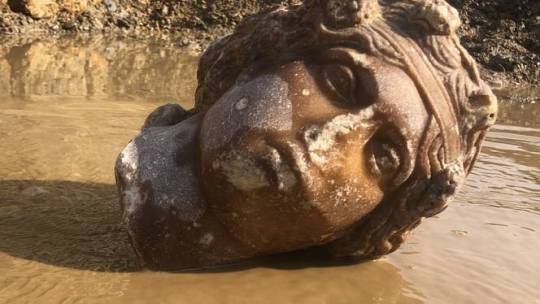
Turkish Archaeologists Unearth Sculpted Heads of Ancient Greek Deities
The excavations in Kutahya province’s ancient city of Aizanoi, which is the site of many ancient Greek and Roman-era settlements, discover the statue heads of Dionysus and Aphrodite.
Turkish archaeologists have discovered more sculpted heads of ancient Greek deities during excavations in Türkiye's western Kutahya province.
The statue head of Aphrodite, known as the goddess of love and beauty in Greek mythology, and the statue head of Dionysus, the deity of wine, were discovered during excavation work in an ancient city in central Türkiye.
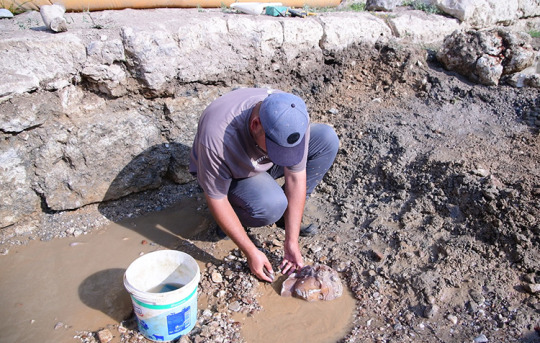
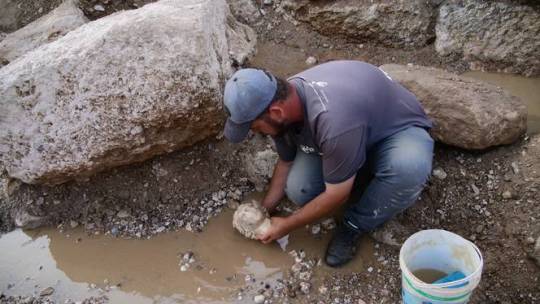
Modern Türkiye is the site of many ancient Greek and Roman-era settlements.
With a history dating back 5,000 years, Aizanoi, situated 50 kilometres (31 miles) from the Kutahya city centre, was included in the UNESCO World Heritage Tentative List in 2012.
Archaeological excavations are currently underway in Aizanoi, which is located in the Cavdarhisar district of Kutahya province and is home to Anatolia's best-preserved Temple of Zeus.
Archaeology professor and excavation team leader Gokhan Coskun told Anadolu Agency that numerous statue pieces were discovered during the excavation.
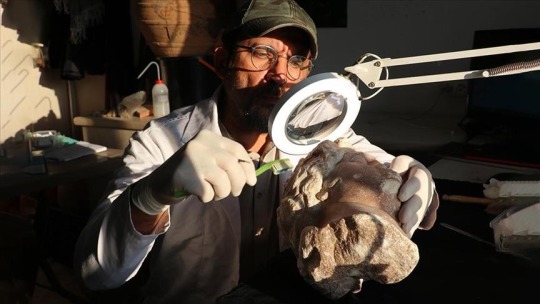
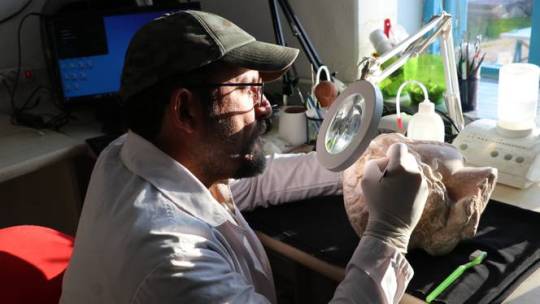
"The most exciting development for us this season is uncovering new heads of the goddess of love and beauty, Aphrodite, and the deity of wine Dionysus," Coskun said.
"In the excavation works we have conducted in the region so far, we have unearthed more than 100 statue pieces. Some of the heads found are from statues that are 2-3 meters long," he noted.
"These statue heads, which we first discovered three years ago, are in very well-preserved condition. During our excavations, so far we have discovered two Aphrodite and three Dionysus statue heads," Coskun said.
The excavation season, which began in the ancient city last April, will be completed by the end of this month, Coskun added.
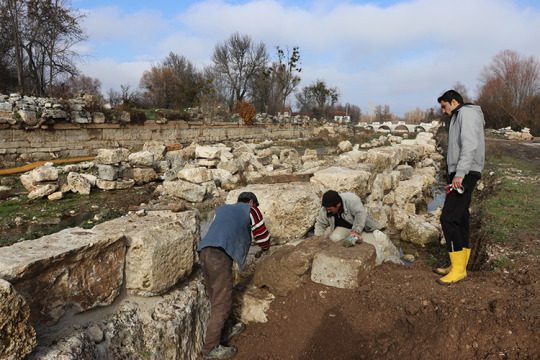
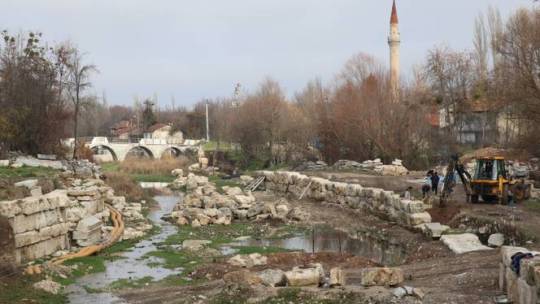
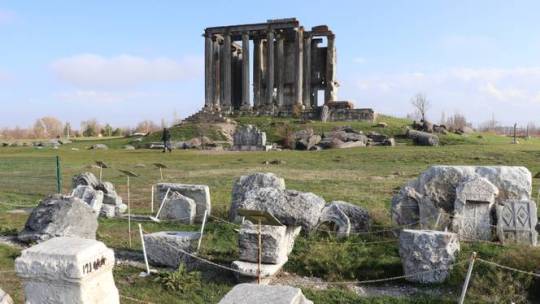
#Turkish Archaeologists Unearth Sculpted Heads of Ancient Greek Deities#ancient city of Aizanoi#Dionysus#Aphrodite#marble#marble statue#marble sculpture#marble head#ancient artifacts#archeology#archeolgst#history#history news#ancient history#ancient culture#ancient civilizations#greek history#roman history#greek art#roman art
305 notes
·
View notes
Text

Pontic Kings Rock Tomb, Amasya, Turkey: The Tombs of the kings of Pontus, located in Amasya, northern Turkey, are rock-carved tombs of different sizes, forming the royal necropolis of the Pontic kings. The site was added to the tentative list in the cultural category of UNESCO World Heritage Site on April 13, 2014. Wikipedia
73 notes
·
View notes
Text

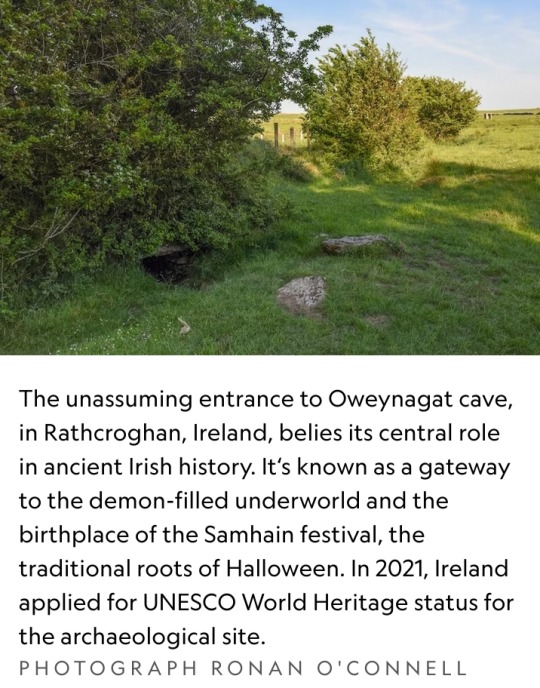
Story and photographs by Ronan O’Connell
September 26, 2023
In the middle of a field in a lesser known part of Ireland is a large mound where sheep wander and graze freely.
Had they been in that same location centuries ago, these animals might have been stiff with terror, held aloft by chanting, costumed celebrants while being sacrificed to demonic spirits that were said to inhabit nearby Oweynagat cave.
This monumental mound lay at the heart of Rathcroghan, the hub of the ancient Irish kingdom of Connaught.
The former Iron Age center is now largely buried beneath the farmland of County Roscommon.
In 2021, Ireland applied for UNESCO World Heritage status for Rathcroghan (Rath-craw-hin). It remains on the organization's tentative list.

Rooted in lore
Spread across more than two square miles of rich agricultural land, Rathcroghan encompasses 240 archaeological sites, dating back 5,500 years.
They include burial mounds, ring forts (settlement sites), standing stones, linear earthworks, an Iron Age ritual sanctuary — and Oweynagat, the so-called gate to hell.
More than 2,000 years ago, when Ireland’s communities seem to have worshipped nature and the land itself, it was here at Rathcroghan that the Irish New Year festival of Samhain (SOW-in) was born, says archaeologist and Rathcroghan expert Daniel Curley.
In the 1800s, the Samhain tradition was brought by Irish immigrants to the United States, where it morphed into the sugar overload that is American Halloween.
Dorothy Ann Bray, a retired associate professor at McGill University and an expert in Irish folklore, explains that pre-Christian Irish divided each year into summer and winter.
Within that framework were four festivities.
Imbolc, on February 1, was a festival that coincided with lambing season.
Bealtaine, on May 1, marked the end of winter and involved customs like washing one’s face in dew, plucking the first blooming flowers, and dancing around a decorated tree.
August 1 heralded Lughnasadh, a harvest festival dedicated to the god Lugh and presided over by Irish kings.
Then on October 31 came Samhain, when one pastoral year ended and another began.
Rathcroghan was not a town, as Connaught had no proper urban centers and consisted of scattered rural properties.
Instead, it was a royal settlement and a key venue for these festivals.
During Samhain, in particular, Rathcroghan was a hive of activity focused on its elevated temple, which was surrounded by burial grounds for the Connachta elite.
Those same privileged people may have lived at Rathcroghan. The remaining lower-class Connachta communities resided in dispersed farms and descended on the site only for festivals.
At those lively events they traded, feasted, exchanged gifts, played games, arranged marriages, and announced declarations of war or peace.
Festivalgoers also may have made ritual offerings, possibly directed to the spirits of Ireland’s otherworld.
That murky, subterranean dimension, also known as Tír na nÓg (Teer-na-nohg), was inhabited by Ireland’s immortals, as well as a myriad of beasts, demons, and monsters.
During Samhain, some of these creatures escaped via Oweynagat cave (pronounced “Oen-na-gat” and meaning “cave of the cats”).
“Samhain was when the invisible wall between the living world and the otherworld disappeared,” says Mike McCarthy, a Rathcroghan tour guide and researcher who has co-authored several publications on the site.
“A whole host of fearsome otherworldly beasts emerged to ravage the surrounding landscape and make it ready for winter.”
Thankful for the agricultural efforts of these spirits but wary of falling victim to their fury, the people protected themselves from physical harm by lighting ritual fires on hilltops and in fields.
They disguised themselves as fellow ghouls, McCarthy says, so as not to be dragged into the otherworld via the cave.
Despite these engaging legends — and the extensive archaeological site in which they dwell — one easily could drive past Rathcroghan and spot nothing but paddocks.
Inhabited for more than 10,000 years, Ireland is so dense with historical remains that many are either largely or entirely unnoticed.
Some are hidden beneath the ground, having been abandoned centuries ago and then slowly consumed by nature.
That includes Rathcroghan, which some experts say may be Europe’s largest unexcavated royal complex.
Not only has it never been dug up, but it also predates Ireland’s written history.
That means scientists must piece together its tale using non-invasive technology and artifacts found in its vicinity.
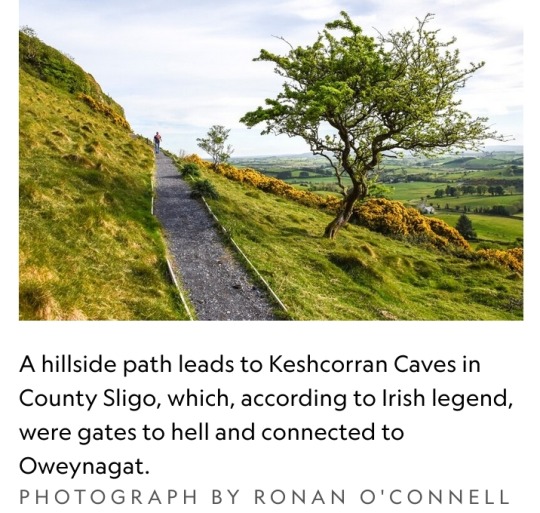
While Irish people for centuries knew this site was home to Rathcroghan, it wasn’t until the 1990s that a team of Irish researchers used remote sensing technology to reveal its archaeological secrets beneath the ground.
“The beauty of the approach to date at Rathcroghan is that so much has been uncovered without the destruction that comes with excavating upstanding earthwork monuments,” Curley says.
“[Now] targeted excavation can be engaged with, which will answer our research questions while limiting the damage inherent with excavation.”
Becoming a UNESCO site
This policy of preserving Rathcroghan’s integrity and authenticity extends to tourism.
Despite its significance, Rathcroghan is one of Ireland’s less frequented attractions, drawing some 22,000 visitors a year compared with more than a million at the Cliffs of Moher.
That may not be the case had it long ago been heavily marketed as the “Birthplace of Halloween,” Curley says.
But there is no Halloween signage at Rathcroghan or in Tulsk, the nearest town.
Rathcroghan’s renown should soar, however, if Ireland is successful in its push to make it a UNESCO World Heritage site.
The Irish Government has included Rathcroghan as part of the “Royal Sites of Ireland,” which is on its newest list of locations to be considered for prized World Heritage status.
The global exposure potentially offered by UNESCO branding would likely attract many more visitors to Rathcroghan.
But it seems unlikely this historic jewel will be re-packaged as a kitschy Halloween tourist attraction.
“If Rathcroghan got a UNESCO listing and that attracted more attention here that would be great, because it might result in more funding to look after the site,” Curley says.
“But we want sustainable tourism, not a rush of gimmicky Halloween tourism.”
Those travelers who do seek out Rathcroghan might have trouble finding Oweynagat cave.
Oweynagat is elusive — despite being the birthplace of Medb, perhaps the most famous queen in Irish history, 2,000 years ago.
Barely signposted, it’s hidden beneath trees in a paddock at the end of a one-way, dead-end farm track, about a thousand yards south of the much more accessible temple mound.
Visitors are free to hop a fence, walk through a field, and peer into the narrow passage of Oweynagat.
In Ireland’s Iron Age, such behavior would have been enormously risky during Samhain, when even wearing a ghastly disguise might not have spared the wrath of a malevolent creature.
Two millennia later, most costumed trick-or-treaters on Halloween won’t realize they’re mimicking a prehistoric tradition — one with much higher stakes than the pursuit of candy.

#Rathcroghan#Connaught#County Roscommon#UNESCO World Heritage#Samhain#Imbolc#Bealtaine#Lughnasadh#Tír na nÓg#Oweynagat cave#Ireland#remote sensing technology#Birthplace of Halloween#Halloween#Royal Sites of Ireland#Halloween tourism#Medb#Oweynagat#Iron Age#Irish history#archaeological site
105 notes
·
View notes
Text




Türkiye 🇹🇷
İZNİK DİKİLİTAŞ 2 BİN YILDIR AYAKTA
İznik’e 5 kilometre uzaklıkta şeftali bahçelerinin tam ortasında yer alan Roma dönemi mezar anıtı obelisk, ihtişamı ile görenleri şaşırtıyor.
Üç yüzeyli, yukarıya doğru yükselen ve birbiri üzerine demir kamalarla oturtulmuş beş beyaz mermer bloktan oluşan anıta, bundan dolayı ‘dikilitaş’ ismi verilmiş.
Anıtın geniş olan birinci taşı üzerindeki Grekçe kitabede;
"C.Cassius Philiscus, C.Cassius Asklepiodotus'un oğlu, 83 yıl yaşadı" yazılı.
Yerli yabancı turistlerin ilgi gösterdiği dikilitaş ihtişamı ile herkesin ilgi odağı haline geldi.
(UNESCO Dünya mirası geçici listesinde bulunuyor)
........
İZNİK DİKİLİTAŞ STANDING FOR 2,000 YEARS
Located in the middle of the peach orchards, 5 kilometers from Iznik, the Roman period obelisk amazes those who see it with its magnificence.
For this reason, the monument, consisting of five white marble blocks with three surfaces, rising upwards and seated on top of each other with iron wedges, was given the name 'obelisk'.
In the Greek inscription on the first stone of the monument;
Inscribed "C. Cassius Philiscus, son of C. CassiusAsclepiodotus, lived 83 years".
The obelisk, which attracted the attention of domestic and foreign tourists, has become the center of attention with its magnificence.
(It is on the UNESCO World Heritage tentative list)
#bursa#Dikilitaş#iznik#roma#tarih#türkiye#doğa#travel photography#travel destinations#travel#manzara#view#natural#europe#africa#Spotify
34 notes
·
View notes
Text

Explore the Ultimate Tanzania Luxury Safari Experience with PoaPoa Tours
Tanzania is a land of diverse landscapes, from vast savannas and towering mountains to lush forests and pristine beaches. For travelers seeking an unforgettable, high-end experience, a Tanzania luxury safari offers the perfect blend of adventure and comfort. PoaPoa Tours is your gateway to exploring this East African gem in style, offering personalized itineraries and luxury accommodations that will leave you in awe.
Why Choose a Tanzania Luxury Safari?
A luxury safari in Tanzania is more than just game drives—it’s a full immersion into the heart of nature, combined with exclusive services. Whether you’re looking to witness the Great Wildebeest Migration in Serengeti, explore the stunning Ngorongoro Crater, or relax in a 5-star lodge after a thrilling day, PoaPoa Tours ensures every aspect of your journey is meticulously planned for your comfort.
Here are a few reasons why a Tanzania luxury safari should be on your bucket list:
Exclusive Lodging: Stay in world-class lodges or tented camps that offer high-end amenities, fine dining, and breathtaking views of Tanzania's wildlife right from your room.
Personalized Safari Experiences: With private guides, you can create your own itinerary, whether you want to focus on bird watching, photography, or witnessing the “Big Five.”
Unforgettable Wildlife Encounters: Watch elephants, lions, leopards, and giraffes in their natural habitat, all while enjoying premium service and accommodations.
Highlights of PoaPoa Tours’ Tanzania Luxury Safari
At PoaPoa Tours, we craft bespoke Tanzania safari experiences tailored to your preferences. Below are some of the key highlights that make our luxury safaris stand out:
Serengeti National Park: Known for the Great Wildebeest Migration, Serengeti is a must-visit for anyone seeking the ultimate safari experience. Enjoy the luxury of private game drives and exclusive lodges within the park.
Ngorongoro Crater: Stay in lodges perched on the edge of this UNESCO World Heritage Site, offering unmatched views and opportunities for game viewing.
Tarangire National Park: Famous for its large elephant herds, Tarangire offers a unique mix of lush landscapes and luxury accommodations.
Private Bush Dinners and Hot Air Balloon Rides: Make your safari even more special with private dining experiences under the African stars or a hot air balloon safari at sunrise.
Custom Luxury Packages: Whether you’re planning a family getaway, honeymoon, or solo adventure, PoaPoa Tours offers custom luxury safari packages that fit your desires and schedule.
Focus on Sustainability and Community
At PoaPoa Tours, we believe that luxury and sustainability go hand in hand. Our eco-friendly camps and lodges ensure minimal environmental impact while providing a high standard of comfort. Additionally, we support local communities through various initiatives, ensuring that your trip not only leaves a positive impact on you but also on Tanzania's people and wildlife.
Suggested Itineraries for a Tanzania Luxury Safari
10-Day Luxury Safari & Zanzibar Escape: Explore Serengeti, Ngorongoro Crater, and the pristine beaches of Zanzibar. This package combines wildlife with relaxation.
7-Day Luxury Serengeti & Ngorongoro Experience: Perfect for those who want a deeper immersion in Tanzania's most famous wildlife destinations.
14-Day Tanzania & Kenya Combined Safari: For the ultimate African adventure, this cross-border luxury safari covers both Tanzania and Kenya’s best national parks.
Why Book with PoaPoa Tours?
With decades of experience in providing top-tier safari experiences, PoaPoa Tours is your trusted partner for a luxury safari in Tanzania. Our expert guides, luxury accommodations, and commitment to sustainability make us the ideal choice for discerning travelers.
Book your Tanzania luxury safari with PoaPoa Tours today and embark on a journey you’ll never forget!
#TanzaniaLuxurySafari#ExploreTanzania#PoaPoaTours#LuxurySafari#AfricanSafari#SerengetiSafari#NgorongoroCrater#BigFiveSafari#SustainableTourism#SafariExperience
3 notes
·
View notes
Text



Mt. Pulag National Park
 Philippines
Date of Submission: 16/05/2006
Criteria: (ix)(x)
Category: Natural
Submitted by:
Department of Environment and Natural Resources (DENR) - Protected Areas and Wildlife Bureau
State, Province or Region:
Benguet, Ifugao, and Nueva Vizcaya Provinces
Coordinates: N16 30 36 E120 50 20
Ref.: 5030
Export
Word File .doc
Disclaimer
The Tentative Lists of States Parties are published by the World Heritage Centre at its website and/or in working documents in order to ensure transparency, access to information and to facilitate harmonization of Tentative Lists at regional and thematic levels.
The sole responsibility for the content of each Tentative List lies with the State Party concerned. The publication of the Tentative Lists does not imply the expression of any opinion whatsoever of the World Heritage Committee or of the World Heritage Centre or of the Secretariat of UNESCO concerning the legal status of any country, territory, city or area or of its boundaries.
Property names are listed in the language in which they have been submitted by the State Party
Description
Mt. Pulag National Park lies on the north and south spine of the Grand Cordillera Central that stretches from Pasaleng, Ilocos Norte to the Cordillera Provinces. It falls within the administrative jurisdiction of two (2) Regions: Cordillera Administrative Region (CAR) and Cagayan Valley (R2).
The whole park is located within the Philippine Cordillera Mountain Range and is very rugged, characterized by steep to very steep slopes at the mountainsides and generally rolling areas at the mountain peak. Mt. Pulag National Park is the highest peak in Luzon and is the second highest mountain in the Philippines with an elevation of 2,922 m. above sea level.
The summit of Mt. Pulag is covered with grass and dwarf bamboo plants. At lower elevations, the mountainside has a mossy forest veiled with fog, and full of ferns, lichens and moss. Below this is the pine forest growing on barren, rocky slopes. Falls, rivers and small lakes mark the area.
The Park has a large diversity of flora and fauna, many of which are endemic to the mountain. Its wildlife includes threatened mammals such as the Philippine Brown Deer, Northern Luzon Giant Cloud Rat and the Luzon Pygmy Fruit Bat. One can also find several orchid species some of which are possibly endemic to Mt. Pulag, and other rare flora such as the pitcher plant.
Mt. Pulag is an important watershed providing the water necessities of many stakeholders for domestic and industrial use, irrigation, hydroelectric power production and aquaculture.
2 notes
·
View notes
Text
Planned nuclear plant in a Kenyan top tourist hub and home to endangered species sparks protest
Daily Mail. By Associated Press, 12 October 2024 KILIFI, Kenya (AP) – Dozens rallied against a proposal to build Kenya’s first nuclear power plant in one of the country’s top coastal tourist hubs which also houses a forest on the tentative list of the UNESCO World Heritage site. Kilifi County is renowned for its pristine sandy beaches where hotels and beach bars line the 165-mile-long coast…

View On WordPress
0 notes
Text
Top 6 Kazakhstan Tours and Things to Do in 2024
A land of enormous seas, towering mountains, and rich cultural heritage, Kazakhstan beckons travellers with its particular combo of herbal wonders and historic treasures. As the ninth largest country in the world, Kazakhstan's imparting diverse stories for adventurers, history buffs, and nature enthusiasts alike in 2024, this Central Asian gem will showcase tours and sports that promise to have interaction visitors find out in its enchanting splendour and vibrant lifestyle.

In this guide, we spotlight the top six things to visit and activities in Kazakhstan in 2024. From exploring the world-elegance beauty of Almaty to exploring the futuristic skyline of Nur Sultan to the beyond on the pinnacle of discovering the breath taking beauty of Silk Road cities and the Altai Mountains, these studies replicate the high quality that Kazakhstan has to provide. Whether you're a first-time traveller or returning, these tours provide remarkable insight into the coronary heart of this fascinating and dynamic United States of America.
Top 6 Kazakhstan Tours & Things to Do in 2024
1. Explore Almaty, the capital of the way of life

Almaty, the most important metropolis in Kazakhstan, is the U.S.’s cultural and economic centre. Located in the foothills of the Trans-Ili Alatou Mountains, Almaty offers the perfect blend of herbal splendor and urban allure. Exploring Almaty in 2024 must be at the pinnacle of your listing. Start your journey with a visit to the Central State Museum to explore the records and historical past of Kazakhstan. Take a stroll through the Green Bazaar to enjoy neighborhood lifestyles and pattern the wist of Kazakh tradition. Don’t omit Kok-Tobe Hill, which can be reached with the aid of a scenic cable car and offers panoramic perspectives of the metropolis and surrounding mountains. The Medeau Skating Rink and Ski Resort, positioned on the outskirts of the city, is a must-visit for ice sports enthusiasts.
2. Explore the modern wonders of Nur-Sultan.

Formerly known as Astana, the capital Nur-Sultan is a testament to Kazakhstan’s rapid modernization and architecture. In 2024, a guided tour of Nur Sultan will introduce you to its futuristic climate and cultural landmarks. Start at the Byterek Tower, where the observation deck offers panoramic views of the city. Khan Shatir is a large, transparent tent with an indoor beach, shopping, and entertainment facilities. The Hazret Sultan Mosque, one of the largest mosques in Central Asia, and the exhibition-rich National Museum of Kazakhstan are important stops
3. Travel along the Silk Road: Turkestan and Shimkent

The southern parts of Kazakhstan have a lot of historical significance, especially the ancient Silk Road cities of Turkestan and Shimkent. Walking through these cities in 2024 will take you back in time. Turkestan is home to the Tomb of Khoja Ahmed Yasavi, a UNESCO World Heritage Site and a masterpiece of Timurid architecture. Explore the vibrant local markets in Shimkent and visit the Aksu-Zhabagli Nature Reserve, the oldest nature reserve in Central Asia, known for its diversity of flora and fauna. These towns allow you to see the fascinating fabric of Kazakh history and culture.
4. Experience the majestic Altai Mountains.
For nature lovers and adventure seekers alike, the Altai Mountains of East Kazakhstan offer unparalleled beauty and outdoor activities. Visit in 2024 to see the pristine landscape of this remote county. Walking, horseback riding, and wildlife watching are popular activities in Altai. Katon-Karage National Park, the largest national park in Kazakhstan, is known for its diverse ecosystems of forests, mountain meadows, and glacial lakes. Ancient cemeteries dating back to the 3rd century BC
5. Unlock the mysteries of Charin Canyon
Often called the Grand Canyon of Central Asia, Charin Gorge is a herbal wonder placed approximately 200 kilometres east of Almaty. A day trip to Charin Canyon in 2024 will leave you in awe of the extraordinary rock formations and colours. The valley stretches for 154 kilometres, with many spectacular hiking trails. One part of the valley, the Valley of Forts, is mainly well-known for its towering cliffs that resemble medieval castles. Guided excursions monitor the geological history and specific plants and fauna of the vicinity.
6. Take a dip in the tranquillity of Lake Balkhash.
The lake is split into awesome sections: the western half is fresh water, and the Japanese half is salty. Visiting Lake Balkhash in 2024 offers the opportunity to fish, boat, and relax on its sandy shorelines. Surrounded by numerous natural worlds, it's remarkable vicinity for chicken-looking and nature pictures. Local excursions typically include visits to nearby fishing villages, where you may enjoy conventional Kazakh hospitality and food.
Conclusion
Discover the top six Kazakhstan tours and activities in 2024. The country’s natural beauty, cultural heritage, and display of modern wonders promise rich and diverse travel experiences from the cultural depths of Almaty, the futuristic delights of Nur Sultan, the historical charm of Silk Road cities, breath taking views of the Altai Mountains, and Balkhash. The serene expanse of the lake and every destination offer a unique experience to suit every traveller’s taste. To fully immerse yourself in these adventures, consider booking Kazakhstan tour packages from uae, which offer comprehensive and convenient ways to explore the best of this fascinating country. The most important of these
#Kazakhstan tour packages from uae#Kazakhstan tour packages#Kazakhstan Holiday packages from uae#Kazakhstan#Kazakhstan tour#Kazakhstan Travel#Kazakhstan history#Kazakhstan tour destinations
1 note
·
View note
Text
Songkhla's Old Town Eyes UNESCO World Heritage Status:
via Bangkok Post, 21 Sep 2023: Local authorities and civic groups in Songkhla are collaborating on a development and management plan to nominate the province's old town for inclusion in UNESCO's tentative list of World Heritage Sites.
via Bangkok Post, 21 Sep 2023: Local authorities and civic groups in Songkhla are collaborating on a development and management plan to nominate the province’s old town for inclusion in UNESCO’s tentative list of World Heritage Sites. The provincial administrative organisation (PAO) and civilsociety of this southern region are pressing ahead with a plan to includeSongkhla’s old town in the…

View On WordPress
0 notes
Text

1,800-Year-Old Surgical Tools Found at Zerzevan Fortress in Turkey
The fortress, located in the Chinar district, has a history that extends back to nearly 3,000 years. Due to its historical significance, it has been included by UNESCO alongside other heritage sites on the tentative list of world heritage.

#1800-Year-Old Surgical Tools Found at Zerzevan Fortress in Turkey#Historical Fortress of Zerzevan#ancient artifacts#archeology#archeolgst#history#history news#ancient history#ancient culture#ancient civilizations#roman history#roman empire#roman legion
40 notes
·
View notes
Text
Las Labradas: Mexico's Largest Collection of Ancient Petroglyphs
Las Labradas Archaeological Zone, located on the coast of Sinaloa, Mexico, roughly 35 kilometers north of Mazatlan, is a remarkable open-air museum showcasing the largest concentration of petroglyphs (rock carvings) ever discovered in the country. While not yet a UNESCO World Heritage Site, it has been on the tentative list since 2012 in recognition of its outstanding universal value. A Unique…

View On WordPress
#archaeology#beach#conservation#cultural heritage#Las Labradas#mazatlan#mexico#petroglyphs#pre-Columbian#rock art#Sinaloa#UNESCO
0 notes
Text
Sakteng Wildlife Sanctuary, Bhutan: An Exciting Safari Guide

Experience a Bhutan Trip unlike any other as you explore the captivating Sakteng Wildlife Sanctuary, home to verdant meadows, lush woods, and glistening streams. Sakteng Wildlife Sanctuary in Bhutan offers an amazing experience for those interested in birdwatching, trekking, or just finding peace in nature.
Nestled in the heart of Bhutan's unspoiled wilderness, the calm and enchanting Sakteng Wildlife Sanctuary is a popular destination for adventure seekers. This wildlife sanctuary in Bhutan, listed in the tentative list of UNESCO World Heritage Sites, is a haven for nature lovers and adventure seekers.
Sakteng Wildlife Sanctuary is home to a diverse range of flora and animals, including uncommon species such as snow leopards and red pandas. It provides an exceptional chance to discover Bhutan's wild and unspoiled landscapes.
How to Get There: Sakteng Wildlife Sanctuary's Location

Sakteng Wildlife Sanctuary is tucked away close to the town of Trashigang in Bhutan's eastern region. Sakteng Wildlife Sanctuary Bhutan, which borders the northeastern state of Arunachal Pradesh, is well-known for its abundant biodiversity, immaculate scenery, and cultural significance.
Sakteng Wildlife Sanctuary is home to a wide variety of plants and animals and spans an area of about 740 square kilometers. There are various ways to get from India to Sakteng Wildlife Sanctuary:
By airways:
The Sakteng Wildlife Sanctuary's closest airport is located in Guwahati, Assam, India. The closest airport to Trashigang is Paro International Airport in Bhutan, which is reachable by plane from Guwahati Airport. You have two options for getting to Yongphulla Airport in Trashigang from Paro: by car or via connecting flight.
By Roadways:
You can travel to Bhutan by beautiful road from Guwahati. The path passes through charming villages and verdant surroundings before entering Bhutan at Samdrup Jongkhar. You can then carry on to Sakteng Wildlife Sanctuary, which is located in Trashigang.
By Railways:
While there aren't any direct train links to Bhutan, you can take major Indian cities to Guwahati or New Jalpaiguri in West Bengal via train. You can then go by vehicle to Guwahati Airport and take the previously specified flight or road route to Sakteng Wildlife Sanctuary. Traveling to Sakteng Wildlife Sanctuary can be done by plane, car, or rail, and it's guaranteed to be an exciting trip with amazing scenery and life-changing encounters.
CONCLUSION
Finally, we would like to say that our tour of Bhutan's Sakteng Wildlife Sanctuary has been an exciting adventure into the core of conservation and biodiversity. Every step shows the astounding diversity of plant and fauna that make this sanctuary home, from the immaculate forests to the rough rocky terrain. With the help of our safari guide, we have learned more about the variety of species that call this place home, including bright Himalayan birds and elusive snow leopards, as well as the delicate balance that must be maintained between human activity and the preservation of wildlife. May our experiences inspire a desire for environmental stewardship and a dedication to preserving Bhutan's remarkable wilderness for future generations as we say goodbye to this refuge of natural wonders.
0 notes
Text







📍 Eşrefoğlu Camii, Konya
🕌 Anadolu Selçukluları döneminde inşe edilen ve 2012'de UNESCO Dünya Mirası Geçici Listesi’ne alınan yapı, 48 ahşap direğin üzerine oturtulmuş tavanı, kündekâri sanatıyla yapılmış pencereleri, minberi ve mahfil çinileriyle dikkat çekiyor.
.......
📍 Esrefoglu Mosque, Konya
🕌 The building, which was built during the Anatolian Seljuk period and included in the UNESCO World Heritage Tentative List in 2012, draws attention with its ceiling mounted on 48 wooden poles, windows made with the art of kündekari, its pulpit and mahfil tiles.
📸: Serhat Cetinkaya, AA
#anadoluselçuklu#cami#türkiye#doğa#travel photography#travel destinations#travel#manzara#view#natural#europe#africa
24 notes
·
View notes
Text
Tent Peak Climbing
Tent Peak Climbing Highlights
Visit the famous places in Kathmandu that are listed as UNESCO World Heritage sites.
Scenic ride from Kathmandu to Pokhara with beautiful views.
Look closely at the tall mountains like Machhapuchhre and Annapurna I.
Enjoy the pretty scenes of the Annapurna range and a big icy area with waterfalls.
Watch a fantastic sunrise over the Himalayas and see magical landscapes.
Relax in the warm water at Jhinu Danda.
Walk through pretty villages and colorful forests.
Be amazed at the incredible 360-degree view from Annapurna Base Camp.
Enjoy the warm hospitality of the local people
Climb the Tent Peak (5,669m) or Tharpu Chuli.
Learn about the culture and lifestyle of the Magar and Gurung people.
Tent Peak Climbing Overview
Tharpu Chuli commonly known as Tent Peak is a magnificent mountain located in the Annapurna Range of the Himalayas. In 1956, Sir Jimmy Robert called it the Tent Peak because of the shape of its summit flat like the tent. Being 5,663 meters above sea level, it is less difficult than other peak climbing making it perfect for beginners as well.
This trek takes you to the idyllic towns of Nayapul, Tikhedhunga, Ulleri, Ghorepani, Tadapani, Chhomrung, Sinuwa Danda, Bamboo, Dovan, Himalaya, Deurali, Machhapuchhre Base Camp, and Annapurna Base Camp. If you are fortunate, you may also encounter endangered species such as snow leopards, musk deer, and Himalayan black bears during the trip.
The most prominent feature of the Tent Peak climbing expedition is the 360-degree view from the top of Annapurna massif. It is an amazing experience full of excitement of climbing and an opportunity to be acquainted with beautiful nature all around.
Tent Peak is pretty popular amongst the trekkers and climbers of the Annapurna region, and its considerably lower altitude makes it an excellent solution for those who are looking for an adventure that is both difficult and satisfying, but not too extreme like the Mera, Lobuche, or Island peaks.
In the end, Tent Peak presents you with a memorable trip with the combination of thrill, adventure, cultural discovery, and the magnificence of the Himalayas.
Itinerary Detail Close All
Day 1 : Arrival In Kathmandu -1400 .
Welcome to the land of the beautiful Himalayas. After you exit from the immigration office at TIA, our representative will be there to pick you up. Then, you will be transferred to the hotel of your choice and location. Then you can refresh yourself and take a rest for tomorrow's day trip inside the valley.
Accomodation
Hotel
Day 2 : Sightseeing and Preparation For The Trek -1400 M .
Early in the morning, after you finish your breakfast, our staff will be there to pick you up from the hotel. There are a total of 7 UNESCO World Heritage sites in Kathmandu. From the list, you can choose the few that you would like to go to because visiting all of them is not possible in one day.
Here is the list:
Kathmandu Durbar Square
Bhaktapur Durbar Square
Patan Durbar Square
Swayambhunath
Boudhanath
Pashupatinath
Changunarayan
Also, don't forget to bring the important document as we will do some paperwork for the Tent Peak Climbing and a short briefing related to this trek at our office.
Food
Breakfast
Accomodation
Hotel
Day 3 : Drive From Kathmandu To Pokhara 6-8 hours -820 M .
We will start our journey early in the morning on a tourist bus from Kathmandu to Pokhara. It'll be a 6-8 hour ride, but don't worry about food – we'll take a break for lunch along the way. The road is in good condition, and you'll get to enjoy scenic views of rivers, forests, and farmland. Eventually, we'll arrive in the beautiful city of Pokhara. Get ready for a relaxing and picturesque ride.
Food
Breakfast
Accomodation
Hotel
Elevation
820
Day 4 : Drive From Pokhara To Nayapul And Trek To TikheDhunga (1,577m), 3 Hours
After spending the beautiful night in Pokhara today, we will head toward Nayapul. It will take us about an hour to reach Nayapul. Our first day of trekking begins here, in Nayapul. Your porters will help you to carry your language. Then, with the help of your Guide, we will start our trek. Today's trek will be short and very easy.
After we pass a string of shops and tea houses, we will take a left turn at a trail junction and reach the charming village of Birethanti, nestled at 1,040 meters. It's where the Modi Khola and Bhurungdi Khola rivers meet. Birethanti offers plenty of lodges and shops. Further crossing a suspension bridge over the Modi Khola, we will reach the ACAP checkpoint.
Moving on, we pass through Sudame, both with places to grab refreshments. Continuing our journey, we arrive at Hille (1,430m), where more lodges and teahouses await. A short uphill climb from Hille, on the east bank of the Bhurungdi Khola, you will reach Tikhe Dhunga. Then, you will spend your night in a tea/guest house.
Food
Breakfast /lunch/dinner
Accomodation
lodge
Elevation
1577
Day 5 : Trek To Ghorepani (2,840 M), 5 Hours
After a delicious local breakfast, we are ready for our trek to Ghorepani. Today's journey takes us from Tikhedhunga to the uphill climb of Ulleri, passing through the vibrant Magar settlements. As we ascend from Ulleri, the path becomes gentler, leading us through beautiful forests of rhododendrons and oaks. After a couple of hours from Banthanti, we finally arrive at Ghorepani, where we will spend the night in a cozy tea/guest house.
Food
Breakfast /lunch/dinner
Accomodation
lodge
Elevation
2840
Day 6 : Trek To Tadapani (2,610 M) And Explore Poon Hill (3,210 M), 6 Hours
After leaving the tea house at Ghorepani, we will start your day with a climb to Poonhill before the sun wakes up. It takes about an hour to reach this beautiful hill. From the top, you will see an amazing sunrise over the Annapurna mountains. After enjoying hot coffee or tea with a beautiful view, you will then go back for breakfast at your lodge.
After breakfast, start walking through a beautiful forest to Tadapani. The trail has some ups and downs, but it's fun. We will stop for lunch in a sunny place called Banthanti. Then, keep going up and down until you reach Tadapani, where you'll spend the night.
Food
Breakfast /lunch/dinner
Accomodation
lodge
Elevation
2610
Day 7 : Trek To Chhomrong (2,140 M) From Tadapani (2,610 M), 5 Hours
Today is another beautiful day for trekking, where you will be walking down through the pretty rhododendron forest. You can hear the lovely melody of birds singing as you walk along the trail. After about 45 minutes of walking, the path gets steep downhill through terraced fields, leading to a suspension bridge over the Kimrong Khola.
Then, the trail goes up, and you walk straight to Chhomrong, which is at 2140 meters above sea level. It will take about five hours from Tadapani to reach Chhomrong.In Chhomrong, you can see beautiful Mt. Annapurna south, Himchuli, the Virgin Peak, and Mt. Machhapuchhre up close. The village is filled with Gurung people, and you will have a great chance to experience their warm hospitality.
Food
Breakfast /lunch/dinner
Accomodation
lodge
Elevation
2139
Day 8 : Trek Dovan (2,500 M) From Chhomrung (2,140 M), 6 Hours
Today, we will be trekking from Chhomrung to Dovan. Dovan is situated about 2,500m/8,202ft high, and it will take around 5-6 hours to reach on average. The trail starts with steep stairs down to the Chhomrung Khola River. Then, we will cross a hanging bridge at 1,900m/6,233 feet and climb back up to Sinewa, at 2,340m/7,677 feet, where we take a tea break.
After that, we climb more to Khuldighar and then follow a mix of trails with some ups and downs, reaching Bamboo at 2,300m/7,546 feet. After leaving the forest and walking steeply downhill to Dovan village at 2,505m/8,218 feet. Then, reaching the Davan village, we spent the night at a lodge.
Food
Breakfast /lunch/dinner
Accomodation
lodge
Elevation
2500
Day 9 : Trek To Deurali (3,230 M) From Dovan (2,500 M), 4 Hours
In the morning at Dovan, breathe in the fresh mountain air and have a hearty breakfast at your teahouse. After getting ready, we will start our trek towards Deurali with the prominent Annapurna peaks in the background. The path goes through thick forests and greenery, creating a peaceful atmosphere.
During our trek, we'll stop at a teahouse for a tasty lunch, giving us energy for the journey. As we walk, we'll pass by the scenic Modi Khola valley, with the river beside us. The trail includes rocky parts, rhododendron forests, and open areas offering glimpses of the surrounding mountains.
Heading towards Deurali, at 3,230 meters (10,595 feet), the landscape changes as we go higher. It's rewarding to see the elevation rise and feel a sense of achievement. Upon reaching Deurali, we will check into a teahouse or lodge for a well-deserved rest. In the afternoon, we will explore around Deurali, maybe meeting other trekkers and sharing our trail stories. As the day winds down, enjoy a warm dinner at the teahouse, taking in the peaceful mountain atmosphere.
Food
Breakfast /lunch/dinner
Accomodation
lodge
Elevation
3229
Day 10 : Trek To The Annapurna Base Camp (4,131 M) From Deurali (3,230 M), 5-6 Hours .
We've been trekking through beautiful green forests for the past few days, surrounded by the lushness of nature. But today marks a change in scenery. As we ascend, the familiar tree lines start to fade away, giving way to alpine bushes and shrubs.
Our trail takes us through Bagar, nestled at 3300 meters, and then to Machhapuchhre Base Camp at 3700 meters. Finally, we'll reach the breathtaking Mount Annapurna Base Camp at 4130 meters.
At the Annapurna Base Camp (ABC), there are a few cozy lodges that provide a delightful stay. From here, you're treated to mesmerizing views of snow-capped peaks all around the base camp. It truly feels like a magical place where you can immerse yourself in the wonders of nature.
Food
Breakfast /lunch/dinner
Accomodation
lodge
Elevation
4131
Day 11 : Acclimatization Day At The Annapurna Base Camp (4,131m) .
After reaching the Annapurna Base Camp at a height of 4,130 meters (13,547 feet), it's time to focus on getting used to the altitude. Your day starts with a briefing from the climbing leader. They will update you on the glacial trail conditions. Your expert Guide will give you basic mountaineering training on this day.
During this training, you will practice going up and down using ropes and learn essential skills like using an ice axe, snow bar, ice screw, harness, jumar, crampons, and more. Knot tying with main and fixed ropes will also be a part of your skill set by the end of the day.
This training not only gives you crucial knowledge on how to use the climbing gears but also boosts your confidence for the summit attempt the following day. As part of the acclimatization process, you will take short hikes around the base camp in the afternoon. Afterward, it's time to rest and gear up for the exciting adventure ahead of scaling the summit. With your new skills and acclimatization to the high altitude, you will be ready for the upcoming challenge.
Food
Breakfast /lunch/dinner
Accomodation
lodge
Elevation
4131
Day 12 : Trek To Tent Peak Base Camp (4,400 M) From The Annapurna Base Camp (4,131 M), 5 Hours
Now, we are planning a shorter walking day to steer clear of any issues with the thinning air and to acclimate ourselves better for the Tent Peak climb. Your Guide will share crucial information about the upcoming climb and outline the activities for the next day.
Starting today, we will be staying in tented camps for the next two days, and our meals will be prepared by a skilled professional cook right at the campsite. It's a change in scenery and accommodation, adding a touch of adventure as we prepare for the exciting climb ahead.
Food
Breakfast /lunch/dinner
Accomodation
Tented camp
Elevation
4400
Day 13 : Climb To The High Camp (5,000 M) .
Before tackling the peak climb, we must make another trek to a high camp for preparation. The climb involves technical sections, so getting ready is key to a successful ascent.
We will head northwest following a deep-cut gully. After that, the trail takes us to the top of the gully, passing through hills until we reach a ridge. Then, the final stretch involves a climb to a spot at 4877 meters. Once you are at the high camp, we will set up our tents. From the high camp, we can see all around us, and it is amazing.
We can see the panoramic views of giant mountains like Hiunchuli (6441m), Annapurna South (7229m), Annapurna I (8091m), Machapuchhre, and many others. It's like being surrounded by a breathtaking picture of towering peaks. As night falls, we're treated to a spectacular view of the starry sky, making it a memorable night in the mountains.
Food
Breakfast /lunch/dinner
Accomodation
Tented camp
Elevation
5000
Day 14 : Attempt To The Summit (5,850 M) .
In the early morning, we begin our climb to the summit, which sits at an altitude of 5850 meters. Then, we stroll on flat snow for around 1 hour. After that, we climb a steep part that's at a 70-degree angle. To reach the very top, we use special ropes for about 30 minutes. Finally, we walk on a flat path for a bit and reach the summit of Tent Peak.
Once you reach the top, take a moment to feel happy and enjoy the fantastic view. You can see the panoramic view of Annapurna I, Annapurna III, Annapurna V, Gangapurna, Hiunchuli, Annapurna South, Machhapuchhre (Fish-Tail) and Singu Chuli or Fluted Peak. You can also snap some pictures to remember this special time. It's a time to celebrate and appreciate the incredible scenery around you.
Food
Breakfast /lunch/dinner
Accomodation
Tented camp
Elevation
5850
Day 15 : Trek Back To Deurali From Tent Peak Base Camp, 6 Hours
Today, after leaving Tent Peak Base Camp, the path goes down through thick forests and greenery next to the Modi Khola River. Stay vigilant at every step of the way, and be especially careful when tackling steep areas and crossing streams. When you get to Deurali, a calm place surrounded by big mountains, you will find a nice guesthouse to sleep in. Relax and enjoy the peacefulness of the mountains for the night.
Food
Breakfast /lunch/dinner
Accomodation
lodge
Elevation
3230
Day 16 : Trek Back To Sinuwa From Deurali, 6 Hours
Today, you will start descending through the same path that took you to Annapurna Base Camp. Your trek starts from Deurali enjoying the peaceful ambiance of the village and the surrounding mountains. You will start descending through the Modi Khola valley. After a while, you will reach Hinku Cave. You can take a short break at Hinku Cave, perhaps enjoying a snack and admiring the scenery before continuing your trek.
Then you will resume your trek from Hinku Cave continuing along the trail towards the Himalaya Hotel. Before reaching the hotel you will pass through lush forests and rocky terrain. Then after reaching the hotel you can rest and refuel your body by having an appetizing lunch. Also don't forget to keep your body hydrated. Then leaving the hotel and continuing your journey you will reach Dovan. Further walking from Dovan you will reach Bamboo. Then from Bamboo, you will ascend gradually towards Sinuwa. After reaching the Sinuwa you will enjoy the night in the tea house with the warm hospitality of local people.
Food
Breakfast /lunch/dinner
Accomodation
lodge
Elevation
2300
Day 17 : Trek Back To Jhinu (1,500 M) From Sinuwa, 4 Hours
You will walk downhill from Sinuwa to Jhinu Danda for about 4-5 hours. When you get to Jhinu Danda, take a nice bath in the hot spring. It will make you feel better and ready for more walking. Enjoy the hot bath, and then it's time to rest for the day.
Food
Breakfast /lunch/dinner
Accomodation
lodge
Elevation
1500
Day 18 : Trek To Nayapul And Drive Back To Pokhara, 4 Hours
As we head to Nayapul from Jhinu Danda, you will love the beautiful hills and landscapes in the ACAP region. You will walk for 4-5 hours along Modi Khola and enjoy the stunning views. This part of the trek is easy and flat, making it one of the most pleasant days. After reaching Birethanti, it's just an hour more of walking to Nayapul.
From Nayapul, we'll take a nice and short scenic drive to Pokhara. It's a great spot to chill and enjoy the end of your trek while taking in the beauty of the journey.
Food
Breakfast /lunch/dinner
Accomodation
Hotel
Elevation
820
Day 19 : Drive Back To Kathmandu From Pokhara, 7 Hours
Leaving the beautiful city of Pokhara, you will have a ride to reach Kathmandu. It takes about six to eight hours to drive from Pokhara to Kathmandu. We will travel on the Prithivi Highway, where the roads wind through the hills, giving us scenic views along the Trishuli River. It's a journey with twists and turns, surrounded by beautiful landscapes.
Food
Breakfast /lunch/dinner
Accomodation
Hotel
Elevation
1400
Day 20 : Spare Day In Kathmandu/Sightseeing As An Option
Today, you have a choice: you can chill at the hotel or explore the nearby area. If there are any UNESCO World Heritage sites left to see, you can check them out. Later in the evening, we'll have a little goodbye get-together at a nice restaurant. It will be a simple and pleasant way to end our time together.
Food
Breakfast
Accomodation
Hotel
Day 21 : Final Departure
As we wrap up the trip, filled with memories and the friends you've made, it's time to leave this beautiful country. Our staff will be there to pick you up and take you to your departure.
Not Satisfied with this itinerary?
This represents our standard and highly recommended itinerary. Should this itinerary or date not align with your preferences, we are more than willing to tailor your vacation to meet your specific requirements. The following are our established departure dates. These dates and prices are applicable for joining a group. Allow our travel experts to assist you in personalizing this journey according to your individual interests.
Altitude Graph
What Is Included ?
All Transportation to and from the airport.
Regular hotel stays, twin sharing, bed and breakfast in Kathmandu and Pokhara.
The itinerary's group welcome dinner is scheduled.
full-day guided city tour includes entrance expenses to World Heritage Sites.
If required, private transportation will be provided to and from the trek's beginning and end places.
Full board includes breakfast, lunch, and dinner while on a trekking program.
freshly prepared Our kitchen prepares full board meals for the duration of the Tent Peak climb.
Trekking and climbing responsibly in a two-to-one trekker-to-porter ratio.
Boiled tea, coffee, and drinking water properly when on a tent peak climbing period.
lodging while walking to Annapurna Base Camp in a teahouse or lodge.
During the Tent peak climbing season, accommodations will be at a tent camp with boiled water for drinking, tea, and coffee.
Permit for Tent Peak Climbing, Royalty, and additional government taxes.
Climbing instruction course at base camp for Tent Peak.
All necessary equipment for both solo and group climbing, including a plastic boot, crampons, ice axes, climbing rope, Jumar, harness, figure of eight, carabiners, and more.
There is all the necessary camping gear available, including a two-person member tent.
The equipment that Team Himalaya will require for the expedition includes a down jacket, sleeping bag, and inner fleece liner.
Professional, seasoned trek leader/guide with wilderness training and first aid from the area.
Skilled climbing guide and his assistance team, complete with insurance, necessary equipment, and provision for all costs.
Trek map, Team Himalaya t-shirts, and complimentary Trip Duffle bag.
A peak climbing certificate is granted by the appropriate Nepali government body.
TIMS Trek permit and fees for entry to Annapurna Conservation.
What Is Excluded?
Nepal entry Visa fee; travel insurance of any kind
International Airfare and Airport Tax.
All drinks and main meals in cities.
Tips and Items of personal expenses like the hot water shower, battery charge, telephone call, beverage drinks, and drinking water.
#tentpeakcli#tentpeakexpedtion#tentpeak#tentpeakclimbing#nepalpeak#peakclimb#peak climbing in nepal#nepalex#nepalexpedition#exp#expedition#exped#franklin expedition#belgica expedition
0 notes